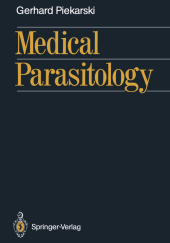 Neuerscheinungen 2012Stand: 2020-01-07 |
Schnellsuche
ISBN/Stichwort/Autor
|
Herderstraße 10
10625 Berlin
Tel.: 030 315 714 16
Fax 030 315 714 14
info@buchspektrum.de |

Gerhard Piekarski, Dora Wirth
(Beteiligte)
Medical Parasitology
Übersetzung: Wirth, Dora
Softcover reprint of the original 1st ed. 1989. 2012. xii, 363 S. XII, 363 pp. 33 plates, mostly in col
Verlag/Jahr: SPRINGER, BERLIN 2012
ISBN: 3-642-72950-9 (3642729509)
Neue ISBN: 978-3-642-72950-8 (9783642729508)
Preis und Lieferzeit: Bitte klicken
Medical Parasitology is primarily intended to be an illustrated textbook which provides a review ofthe most important species ofparasite which occur in man; their areas ofdistribution, morphology and development, the typical disease symptoms resulting from infection, epidemiology and also methods of detection and indications for therapy. The main emphasis is on the protozoan and helmin thic diseases; medical entomology has only been covered in connection with the epidemiology of the diseases described here. Parasites sometimes occur exclusively in man (anthropoparasites) and sometimes also in animals (anthropozoonotic parasites). The monoxenous species complete theirdevelopmentinmanorinoneanimalalone (Scheme I). Heteroxenousspecies, which include most of the medically important parasites, develop partly in man and partly in animals in the course of their life cycle. They may even be forced to infect different species so that they can continue their development. This may sometimes be associated with a digenesis, the larval development taking place in one intermediate (Scheme II ©) or in two different intermediate hosts (Scheme III ©, ¸), andthesexuallymaturestagedevelopinginanotherhost, the so-called definitive host (Scheme III ©). The importance of the intermediate hosts can vary considerably (see below).
Protozoa.- Flagellates.- Trypanosoma brucei gambiense, T. b. rhodesiense.- Trypanosoma cruzi.- Trypanosoma rangeli.- Leishmania donovani, L. tropica, L. braziliensis, L. mexicana.- Flagellates of the Gut and Genitalia.- Giardia lamblia.- Trichomonas vaginalis.- Commensal Flagellates of the Large Intestine.- Amoebae.- Entamoeba histolytica.- Non-pathogenic Amoebae of the Large Intestine.- Acanthamoeba castellanii, Naegleria fowleri.- Primary Amoebic Meningoencephalitis (PAME) and Granulomatous Amoebic Encephalitis (GAE).- Sporozoa, Coccidia.- Sarcocystis suihominis, S. bovihominis.- Sarcocystis lindemanni.- Isospora belli.- Toxoplasma gondii.- Cryptosporidium species.- Pneumocystis carinii.- Malaria, Plasmodium species.- Babesia species.- Ciliates.- Balantidium coli.- Helminths.- Trematodes.- Intestinal Trematodes (Intestinal Flukes).- Fasciolopsis buski.- Echinostoma ilocanum, E. echinatum.- Other Species of Intestinal Trematodes.- Liver Trematodes (Liver Flukes).- Clonorchis sinensis.- Opisthorchis felineus.- Dicrocoelium dendriticum.- Fasciola hepatica.- Lung Trematodes.- Paragonimus westermani, P. kellicotti, P. africanus.- Blood Trematodes.- Schistosomes (Blood Flukes).- Cestodes (Tapeworms).- Diphyllobothrium latum, D. pacificum.- Dipylidium caninum.- Hymenolepis nana, H. diminuta.- Taenia saginata, T. solium.- Echinococcus granulosus, E. (Alveococcus) multilocularis.- Nematodes (Roundworms).- Trichinella spiralis.- Enterobius vermicularis.- Trichuris trichiura.- Ancylostoma duodenale, Necator americanus.- Trichostrongylus orientalis, T. colubriformis, T. axei.- Oesophagostomum species.- Strongyloides stercoralis.- Nematode Larvae as Infectious Agents.- Cutaneous Larva Migrans (Creeping Eruption).- Visceral Larva Migrans (Toxocariasis).- Herring Worm Disease Due to Anisakis marina and Related Species.- Angiostrongylus cantonensis.- Angiostrongylus costaricensis.- Ascaris lumbricoides.- Filariae.- Wuchereria bancrofti, Brugia malayi, B. timori.- Loa loa.- Onchocerca volvulus.- Mansonella ozzardi.- Dipetalonema perstans.- Dipetalonema streptocerca.- Dracunculus medinensis.- Protozoa - Helminths.- Trematoda - Cestoda - Nematoda - Summary.- The Most Important Methods of Microscopic Investigation.- General Preliminary Remarks.- I. Microscopic Examination of the Blood.- II. Examination of Stool Samples.- III. Microscopic Examination of Urine and Sputum.- IV. General Comments on Serological Diagnosis.- Table 1. Prepatent period of various helminths.- Table 2. Summary of the pathogenic intestinal parasites.- Table 3. Extraintestinal blood and tissue parasites.- Table 4. Infection routes and development of intestinal worms.- Table 5. Identification of the most important intestinal protozoan cysts.- Table 6. Identification of the most important helminth eggs.- References.


